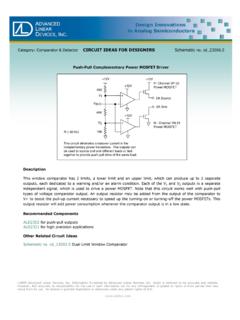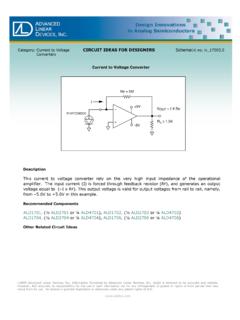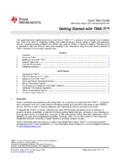Transcription of Buffer Op Amp to ADC Circuit Collection - TI.com
1 Application Report SLOA098 March 20021 Buffer Op Amp to ADC Circuit Collection Bruce Carter High Performance Linear Products ABSTRACT This document describes various techniques that interface Buffer op amps to ADCs. These techniques provide designers with a toolkit of ideas that can be readily adapted to their application. Fully differential, transformer coupled, and single-ended techniques are described. Reference techniques and circuits are also described in Appendix A. Table of Contents 1 Introduction .. 3 Interface Architectural Scheme .. 3 Circuit Icons .. 4 Schematic Conventions .. 5 2 ADC Input and Reference Structure ..6 3 Fully Differential Op Amp Architecture ..8 Single-Ended Input, AC-Coupled, Single 8 Single-Ended Input, AC-Coupled, Dual Supply.
2 9 Single-Ended Input, DC-Coupled, Single Supply .. 10 Single-Ended Input, DC-Coupled, Dual Supply .. 10 Differential Input, AC-Coupled, Single Supply .. 11 Differential Input, AC-Coupled, Dual 11 Differential Input, DC-Coupled, Single 12 Differential Input, DC-Coupled, Dual Supply .. 13 Antialiasing Techniques With Fully Differential Op Amps .. 13 4 Single-Ended Op Amp Techniques .. 14 Single-Ended Output, Single-Ended Input, AC-Coupled, Single Supply .. 15 Single-Ended Output, Single-Ended Input, AC-Coupled, Dual 16 Single-Ended Output, Single-Ended Input, DC-Coupled, Single 17 Single-Ended Output, Single-Ended Input, DC-Coupled, Dual Supply .. 18 Differential Output, Single-Ended Input, AC-Coupled, Single Supply.
3 19 Differential Output, Single-Ended Input, AC-Coupled, Dual Supply .. 22 Differential Output, Single-Ended Input, DC-Coupled, Single-Supply .. 23 Differential Output, Single-Ended Input, DC-Coupled, Dual-Supply .. 24 Differential Output, Differential Input, AC-Coupled, Single 24 Differential Output, Differential Input, AC-Coupled, Dual Supply .. 25 Differential Output, Differential Input, DC-Coupled, Single Supply .. 26 Differential Output, Differential Input, DC Coupled, Dual Supply .. 26 5 Transformer Coupled Interface Techniques .. 27 Single-Ended Input, AC-Coupled, Single 27 Single-Ended Input, AC-Coupled, Dual Supply .. 30 Differential Input, AC Coupled, Single Supply .. 31 Differential Input, AC-Coupled, Dual 32 Appendix A: How to Choose a Reference.
4 33 SLOA098 2 Buffer Op Amp to ADC Circuit Collection List of Figures Figure 1. Circuit Configuration Icons .. 4 Figure 2. Reference Structure of Common ADCs .. 7 Figure 3. Single-Ended Input, AC-Coupled, Single 8 Figure 4. Single Ended Input, AC-Coupled, Dual Supply .. 9 Figure 5. Single-Ended Input, DC-Coupled, Single Supply .. 10 Figure 6. Differential Input, AC-Coupled, Single Supply .. 11 Figure 7. Differential Input, AC-Coupled, Dual Supply .. 11 Figure 8. Differential Input, DC-Coupled, Single Supply Common Mode From 12 Figure 9. Differential Input, DC-Coupled, Single Supply Common Mode From ADC .. 13 Figure 10. Antialias Filter Using a Fully Differential Op Amp .. 14 Figure 11. Single-Ended Output, Single-Ended Input, AC-Coupled, Single Supply.
5 15 Figure 12. Single-Ended Output, Single-Ended Input, AC-Coupled, Single Supply .. 15 Figure 13. Single-Ended Output, Single-Ended Input, AC-Coupled, Dual 16 Figure 14. Single-Ended Output, Single-Ended Input, AC-Coupled, Dual 16 Figure 15. Single-Ended Output, Single Ended Input, DC Coupled, Single Supply .. 17 Figure 16. Single-Ended Output, Single-Ended Input, DC-Coupled, 18 Figure 17. Differential Output, Single-Ended Input, AC-Coupled, Single Supply .. 19 Figure 18. Alternative Differential Output, Single-Ended Input, AC-Coupled, Single 20 Figure 19. Alternative Differential Output, Single-Ended Input, AC-Coupled, Single 21 Figure 20. Differential Output, Single-Ended Input, AC-Coupled, Dual Supply .. 22 Figure 21. Differential Output, Single-Ended Input, DC-Coupled, Single Supply.
6 23 Figure 22. Differential Output, Differential Input, AC-Coupled, Single 24 Figure 23. Differential Output, Differential Input, AC-Coupled, Dual Supply .. 25 Figure 24. Differential Output, Differential Input, DC-Coupled, Single Supply .. 26 Figure 25. Single Ended Input, AC-Coupled, Single Supply .. 27 Figure 26. Transformer Coupled, Pre-Transformer, Derived Reference .. 28 Figure 27. Transformer Coupled, Buffer on the Secondary Side .. 29 Figure 28. Single Ended Input, AC-Coupled, Dual Supply .. 30 Figure 29. Single-Ended Input, AC-Coupled, Dual Supply .. 30 Figure 30. Differential Input, AC-Coupled, Single Supply .. 31 Figure 31. Differential Input, AC-Coupled, Dual 32 Figure 32. ADC 33 Figure 33. Reference From 34 Figure 34.
7 External Reference .. 34 Figure 35. Dual Reference .. 35 SLOA098 Buffer Op Amp to ADC Circuit Collection 3 1 Introduction In most cases, analog to digital converters (ADCs) also require a Buffer amp. The choice of Buffer op amp, and how to connect it to the ADC, are some of the most challenging tasks facing experienced analog designers much more so with digital designers who are often assigned the task. This document presents designers with a library of interface techniques, but leaves the choice of op amp to other documents. In general, however, op amp specifications that are important to the system design should be much better than the equivalent specification of the ADC Otherwise, money is wasted on an expensive ADC. A good Buffer op amp is usually an order of magnitude less expensive than the ADC, and economizing on a Buffer op amp is a poor decision.
8 This document assumes a differential input ADC, which is standard for high performance ADCs. Section 2 describes the input and reference scheme of differential op amps. Interface Architectural Scheme Designers should first decide on an architectural scheme to interface to the ADC. There are three schemes to choose from: Fully differential op amps: The best performance comes when fully differential ADCs are buffered with fully differential op amps. Transformer coupling: This is also a commonly used method, but it has significant limitations such as frequency response, dc blockage, and the size, cost, and lack of standardization of the transformer. Single-ended op amps: If a fully differential op amp cannot be selected to meet system performance requirements, one or more single-ended op amps may be used to simulate fully differential architecture.
9 There are several choices to be made within each architectural category. These are dictated by system constraints and include: Single-ended input signal vs fully differential input to the Buffer op amp. Single-ended interface to the ADC (where one input is tied to a reference or a common mode level) vs fully differential input. Single-ended input should only be used when performance and accuracy are not of paramount importance, but board space and cost are. AC-coupled vs dc-coupled signal chain. Most RF and audio applications can be ac-coupled, which greatly simplifies design. Many transducer interface applications must be dc-coupled. Single-supply vs dual-supply power. The vast majority of applications are single supply, as the ADC is probably operated from a single supply and its input range is entirely within a positive range that does not include ground.
10 A single supply op amp whose supply voltage matches that of the ADC is preferable to avoid the possibility of damage to the ADC. SLOA098 4 Buffer Op Amp to ADC Circuit Collection There may be performance constraints on the op amp, however, that dictate the use of a dual supply variety. These four items give 16 different possibilities and in some cases there are multiple implementations for each possibility. Fortunately for the designer, not all of these combinations make sense. Transformer coupled applications, for example, do not need to include dc coupled cases because the transformer itself blocks dc. Fully differential op amp configurations do not use a single-ended connection scheme to the ADC. It makes no sense to purchase a fully differential op amp, and then not use the differential output to interface to the differential input of the ADC.












